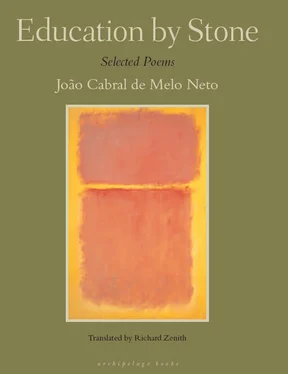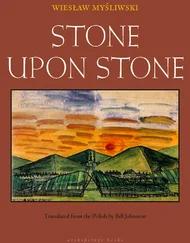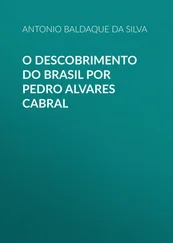Although the Portuguese word for silk, seda , seems like it could be related to sedante , “sedative” (third stanza), in fact there is no etymological connection.
Yes Against Yes
Only the first half the poem is included here. Two more poets — Portugal’s Cesário Verde and Brazil’s Augusto dos Anjos — and two more painters — Juan Gris and Jean Dubuffet — are considered in the second half.
Rivers for a Day
The Sertão is the arid and impoverished hinterland of Northeast Brazil.
Psychoanalysis of Sugar
In primitive, unmechanized sugar mills, clay was added to the sugar as part of the bleaching process.
The Kingdoms of Yellow
The Mata is the fertile coastal region of Pernambuco where sugarcane is grown. In the fourth line of the second stanza, the word sarro does not mean “pus” but refers to the white coating (or “fur”) on the tongue resulting from hunger or sickness.
Fort Orange, Itamaracá
Itamaracá is an island off the coast of Pernambuco.
The Sandbank at Sirinhaém
The Sirinhaém is a river that empties into the Atlantic in southern Pernambuco.
In the Páramo
Chimborazo is the highest mountain (20,561 feet) in Ecuador, where the poet served as the Ambassador of Brazil from 1979 to 1982.
“A stone is a stone is a stone” could not be a poem by João Cabral de Melo Neto, but it could be an epigraph to his poetry, a notice at the gates that the language within is plain and direct and that the subject matter is mineral, touchable, weighable, thingish. A stone is preferable to a rose for the simple reason that it is harder. This poet never liked what was easy. In “The Unconfessing Artist” he recognized that doing something is as useless as not doing anything, yet he insisted that it’s better to do. Why? Because it’s harder than not doing. It was only hard things like stones that held any poetic attraction for João Cabral. He considered poems made out of flowers to be, at best, a redundancy. Whereas poems made out of what’s harsh, rugged and lifeless might add a new sliver of something — perhaps beauty — to the world and might even, in a slight way, change how we see.
Stones have no fragrance, but they are heavy with substance and endure. João Cabral, whose second book was titled The Engineer , wanted each of his poem-building words to “weigh as much as the thing it tells.” By fusing “the loose word” to “the body of its referent,” it would become, according to the “Catechism” he attributed to Berceo (p. 201), the first poet known by name to have written in Spanish, “a solid, dense thing, / able to clash with the one next to it.”
Yet another quality of stone, besides its hardness and resilience, is its sheer and utter stoniness. What you see is what it is, the same material throughout. There is no “inner stone” to probe, ponder, or dress with theories. João Cabral was suspicious of whatever was invisible. He was not a strict materialist, but he preferred solid matter, because it is surer, clearer, and common to all. When he was 32 years old he published an essay criticizing the Brazilian poetry of his own generation for being “made of super-realities, made with exclusive parts of man,” with no greater ambition than “to communicate extremely subtle details, for which the only useful writer’s tool is the lightest and most abstract part of the dictionary.” Cabral preferred “the prosaic word” that is “heavy with reality, dirty with the coarse realities of the outside world.”
One possible explanation for João Cabral’s poetic preference is simple: he was writing out of what he knew. His education by stone was the one he received growing up in Northeast Brazil, the country’s poorest region, largely taken up by the dry and desolate hinterland known as the Sertão. João Cabral was not from the interior but from Recife, on the coast, where thousands of Sertanejos (people from the Sertão) poured in during the drought years. To get there, many of the migrants would follow the path of the Capibaribe River, settling along its shores when at last they reached the city outskirts. The Capibaribe and the poor who inhabit its banks became recurring and indissociable topics in Cabral’s poetry. So destitute were these people — destitute of material means and of any real hope — that their existence was almost wholly defined by the muddy river, making it hard to know “where man (…) begins from the mud” or even “where man begins / in that man” ( The Dog without Feathers ). If there was any lingering consciousness in this dehumanizing environment, it belonged not to man but to the river, credited with knowing how the river dwellers “wither / even beyond / their deepest rubble.” Rubble — crushed stone — in place of a soul.
Another long poem, O Rio (1954; The River), was narrated by the Capibaribe itself, being a chronicle of the journey it makes from its source to Recife, the capital of Pernambuco, passing first through barren country where the inhabitants “arm themselves / with the qualities of stone” in order to fight against it, and continuing through the coastal region known as the Mata, where sugarcane is grown.
It was on the family’s sugar plantations that João Cabral spent his early childhood and received much of his tough “education.” However green and lush the Mata may be, life for those who cut and milled the sugarcane was as gray and meager as in the arid Sertão. A son of privilege, João Cabral never suffered any privation, but he saw it close up, every day, and he remembered what he saw. In the evening the sugar mill workers would gather around and hear the little boy recite popular verse narratives, published in pamphlet form and sold in the marketplace. This kind of versified storytelling — traceable to the narrative poetry traditions of medieval Iberia — became the major vehicle for what could be called Cabral’s “socially engaged” poetry. If this term is used here with reservations, it is because the poet himself never employed any such epithet. The great originality of his poetry in this vein is its absolute objectivity, not only in its dispassion but also in the way it objectifies the poem’s subject.
In “Party at the Manor House,” the plantation owners and their politician friends talk about the sugar mill workers as subhuman creatures, hardly distinguishable from the sugar which is the beginning, middle and end of their exploited lives. Like the poor of Recife who stagnate along the banks of the Capibaribe River, the sugar mill workers have no inner “spiritual man” that can remain untouched by the condition that defines them. The twenty stanzas of this poem amount to a biology of their species, matter-of-factly described “in child form,” “in female form,” “in the form of an old man,” and so forth. In fact there is no “engagement” with the mill worker’s condition. The poet merely reports; let the reader react. Cabral’s childhood contact with those workers, acting as a vaccine (see “Plantation Boy”), gave him a permanent immunity to facile emotional responses. His poetry displays no pity, and hence no condescension.
João Cabral moved with his family to Recife when he was ten years old, and in his late teens he began to frequent the Café Lafayette, where the city’s intellectuals met. A voracious reader, he was especially fond of certain French authors, including Mallarmé and Valéry. He was twenty years old when he met Murilo Mendes and Carlos Drummond de Andrade, probably the two Brazilian poets who most influenced his work, and they helped him publish his first book, Stone of Sleep , in 1942. The poetic images in these early poems were taken from the world of sleep and dreams or else were wrapped in a dreamy, surrealist aura, but the young poet treated them as hard objects, organizing them with careful deliberation, like a cubist his ensemble of fragmented shapes. One of the poems pays homage to Picasso in his cubist period, and another to the surrealist André Masson. Painting was a lifelong passion of Cabral, who published a book-length essay on Joan Miró in 1950. Mondrian was another painter he held in special regard.
Читать дальше










